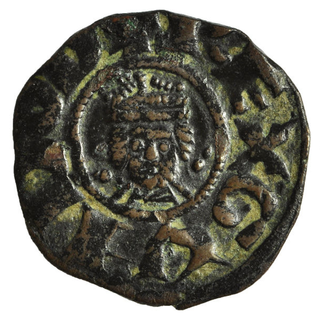
Guy of Lusignan was a French Poitevin knight, son of Hugh VIII of Lusignan and as such born of the House of Lusignan. He was king of Jerusalem from 1186 to 1192 by right of marriage to Sibylla of Jerusalem, and King of Cyprus from 1192 to 1194. Having arrived in the Holy Land at an unknown date, Guy was hastily married to Sibylla in 1180 to prevent a political incident within the kingdom. As the health of his brother-in-law, Baldwin IV of Jerusalem, deteriorated, Guy was appointed by Sibylla as regent for his stepson, Baldwin V of Jerusalem. Baldwin IV died in 1185, followed shortly by Baldwin V in 1186, leading to the succession of Sibylla and Guy to the throne. Guy's reign was marked by increased hostilities with the Ayyubids ruled by Saladin, culminating in the Battle of Hattin in July 1187—during which Guy was captured—and the fall of Jerusalem itself three months later.

Godfrey of Bouillon was a medieval French nobleman and pre-eminent leader of the First Crusade. He became the first ruler of the Kingdom of Jerusalem from 1099 to 1100, although he avoided the title of king, preferring that of prince (princeps) and Advocatus Sancti Sepulchri, or Advocate of the Holy Sepulchre. He was the second son of Eustace II, Count of Boulogne, and Lord of Bouillon, from his mother's inheritance, in 1076. In 1087 Emperor Henry IV confirmed him as Duke of Lower Lorraine, a reward for his support during the Great Saxon Revolt Along with his brothers Eustace III and Baldwin of Boulogne, Godfrey joined the First Crusade in 1096. He took part in actions at Nicaea, Dorylaeum, and Antioch, before playing a key role during the capture of Jerusalem in 1099. When Raymond IV of Toulouse declined the offer to become ruler of the new kingdom, Godfrey accepted the role and secured his kingdom by defeating the Fatimids at Ascalon a month later, bringing the First Crusade to an end. He died in July 1100 and was succeeded by his brother Baldwin as King of Jerusalem.

Raymond IV, Count of Toulouse, sometimes called Raymond of Saint-Gilles or Raymond I of Tripoli, was a powerful noble in southern France and one of the leaders of the First Crusade (1096–1099). He was the Count of Toulouse, Duke of Narbonne and Margrave of Provence from 1094, and he spent the last five years of his life establishing the County of Tripoli in the Near East.

The Principality of Antioch was one of the crusader states created during the First Crusade which included parts of modern-day Turkey and Syria. The principality was much smaller than the County of Edessa or the Kingdom of Jerusalem. It extended around the northeastern edge of the Mediterranean, bordering the County of Tripoli to the south, Edessa to the east, and the Byzantine Empire or the Kingdom of Armenia to the northwest, depending on the date.
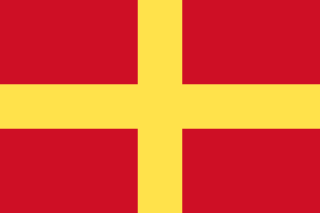
The County of Tripoli (1102–1289) was the last of the Crusader states. It was founded in the Levant in the modern-day region of Tripoli, northern Lebanon and parts of western Syria. When the Frankish Crusaders – mostly southern French forces – captured the region in 1109, Bertrand of Toulouse became the first count of Tripoli as a vassal of King Baldwin I of Jerusalem. From that time, the rule of the county was decided not strictly by inheritance but by factors such as military force, favour and negotiation. In 1289 the County of Tripoli fell to Sultan Qalawun of the Muslim Mamluks of Cairo. The county was absorbed into Mamluk Egypt.
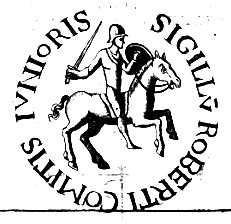
Robert II, Count of Flanders was Count of Flanders from 1093 to 1111. He became known as Robert of Jerusalem or Robert the Crusader after his exploits in the First Crusade.

Bohemond III of Antioch, also known as Bohemond the Child or the Stammerer, was Prince of Antioch from 1163 to 1201. He was the elder son of Constance of Antioch and her first husband, Raymond of Poitiers. Bohemond ascended to the throne after the Antiochene noblemen dethroned his mother with the assistance of the lord of Armenian Cilicia, Thoros II. He fell into captivity in the Battle of Harim in 1164, but the victorious Nur ad-Din, atabeg of Aleppo released him to avoid coming into conflict with the Byzantine Empire. Bohemond went to Constantinople to pay homage to Manuel I Komnenos, who persuaded him to install a Greek Orthodox patriarch in Antioch. The Latin patriarch of Antioch, Aimery of Limoges, placed Antioch under interdict. Bohemond restored Aimery only after the Greek patriarch died during an earthquake in 1170.

The Crusade of 1101 was a minor crusade of three separate movements, organized in 1100 and 1101 in the successful aftermath of the First Crusade. It is also called the Crusade of the Faint-Hearted due to the number of participants who joined this crusade after having turned back from the First Crusade.
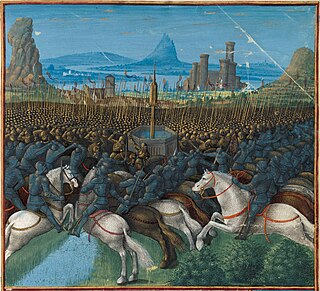
The Battle of Cresson was a small battle between Frankish and Ayyubid forces on 1 May 1187 at the "Spring of the Cresson." While the exact location of the spring is unknown, it is located in the environs of Nazareth. The conflict was a prelude to decisive defeat of the Kingdom of Jerusalem at the Battle of Hattin two months later.
Baldwin of Ibelin, also known as Baldwin II of Ramla, was an important noble of the Kingdom of Jerusalem in the 12th century and was lord of Ramla from 1169-1186. He was the second son of Barisan of Ibelin, and was the younger brother of Hugh of Ibelin and older brother of Balian of Ibelin. He first appears in the historical record as a witness to charters in 1148.
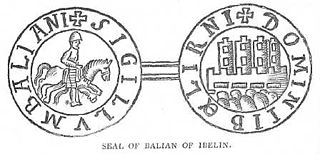
Balian of Ibelin, also known as Barisan the Younger, was a crusader noble of the Kingdom of Jerusalem in the 12th century. He was lord of Ibelin from 1170 to 1193. As the leader of the defense of the city during the siege of Jerusalem in 1187, he surrendered Jerusalem to Saladin on 2 October 1187.
Miles of Plancy, also known as Milon or Milo, was a noble in the crusader Kingdom of Jerusalem.

Reginald Grenier was Count of Sidon and an important noble in the late-12th century Kingdom of Jerusalem.
William VI or Guillem VI was the eldest son of William V and his wife Ermessende, daughter of Count Peter I of Melgueil. William succeeded his father in the lordship of Montpellier in 1121, while still a minor, under his mother's guardianship. He suppressed a revolt of the bourgeoisie in 1143 and participated in several military campaigns of the Reconquista in Spain. He also increased the public character of the lordship in Montpellier and supported the growth of its trade.
The County of Melgueil was a fief of first the Carolingian Emperor, then the King of France, and finally (1085) the Papacy during the Middle Ages. Counts probably sat at Melgueil from the time of the Visigoths. The counts of Melgueil were also counts of Maguelonne and Substantion from at least the time of Peter's homage to Pope Gregory VII on 27 April 1085. In 1172 Beatriu disinherited her son Bertrand and named her daughter Ermessenda her heiress. Later that year Ermessenda married the future Raymond VI of Toulouse and by her will of 1176 the county was to go to Toulouse. Bertrand refused to recognise his disinheritance and pledged homage as Count of Melgueil to Alfonso II of Aragon in 1172. The county fell to the Toulouse in 1190 and was annexed to the French crown in 1213, during the Albigensian Crusade. At the Fourth Council of the Lateran in 1215 it was given to the Diocese of Maguelonne and secular and ecclesiastical authority were merged.

The role of women in the Crusades is frequently viewed as being limited to domestic or illicit activities during the Crusades. While to some extent this is true, they nevertheless played a significant role, taking part in such activities including armed combat in the battles of the Holy Land. This article focuses on the first Crusades and identifies known participants. It also highlights some of the more famous women of the later crusades. For a discussion of the sociological and religious aspects of the mixing of women with the predominantly male crusaders, the reader is referred to the referenced documents.
Raymond Pilet (1075–1120), the only child of Bernard I Pilet of Narbonne and his wife, whose name is unknown. Seigneur of Alès. Bernard was the son of Raymond II, Viscount of Narbone from 1066 to 1067. The name “pilet” refers to a fur that the nobility wore over their cuirass and coats-of-arms. Raymond distinguished himself as a combatant during the First Crusade.
Bernard V, son of Raymond Pilet d’Alès and his wife Mabel, of an unknown family. Count of Meigueil, by right of his wife. Seigneur of Alès. Bernard became Count of Meigueil upon his marriage to Beatrix de Melgueil, in 1146. One source claims Bernard was in the First Crusade, but there is no evidence that this was the case.
The army of Raymond of Saint-Gilles was one of the first to be formed after Pope Urban II called for the First Crusade. Raymond formed a Provençal army and left his County of Toulouse in October 1096, traveling over the land route. He was the only leader of a major army that did not swear an oath of fealty to Byzantine emperor Alexius I Komnenos.
The following is an overview of the armies of First Crusade, including the armies of the European noblemen of the "Princes' Crusade", the Byzantine army, a number of Independent crusaders as well as the People’s Crusade and the subsequent Crusade of 1101 and other European campaigns prior to the Second Crusade beginning in 1147.